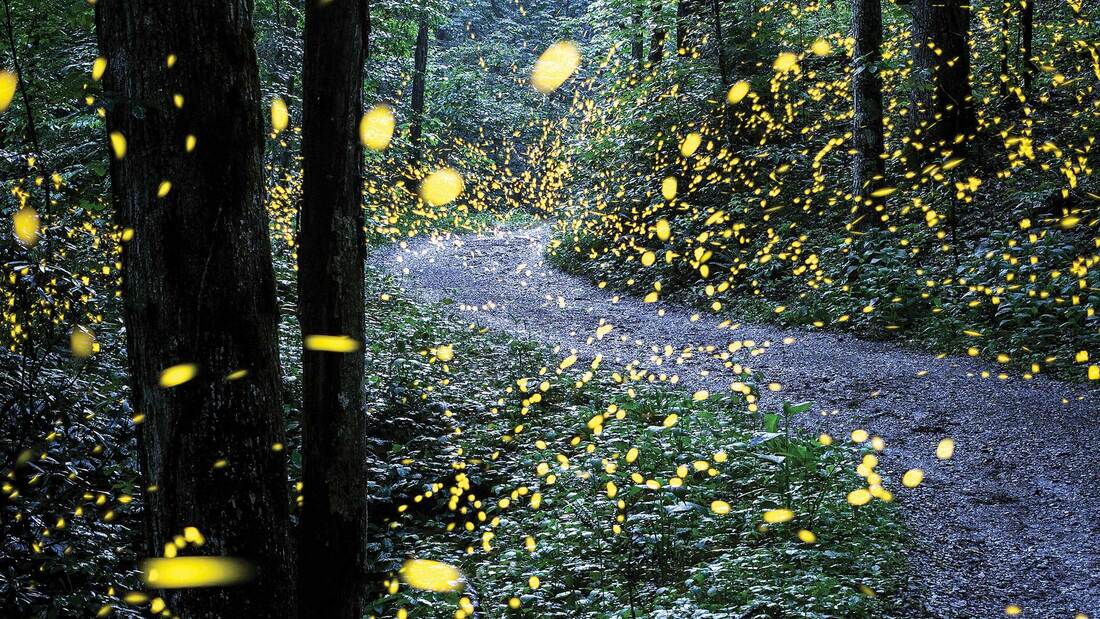 Photo: Radim Schreiber Night falls in the cove where I’ve set up a camera and tripod, one of those places where the sun sets early thanks to steep terrain and thick tree cover overhead. But the darkness doesn’t last. Not long after twilight, the entire forest is pulsing with hundreds of perfectly-timed, golden pinpoints of light. I reach for my camera and start recording video. The lights are from Photinus carolinus, the famed synchronous fireflies that display each year in and around the Elkmont section of Great Smoky Mountains National Park. The fireflies are a biological oddity and visual wonder, with males flashing in unison—a behavior that attracts females—for several weeks each summer. While fireflies are a common occurrence here in the East, this particular species is our only true synchronous flashing insect. Its display in Elkmont attracts thousands of people each year. However, I’m sitting alone in that cove. Elkmont and its crowds are hours away. Instead, I’ve traveled well beyond the national park as a researcher chasing reports of the same species. Synchronous fireflies are known from only a handful of places outside of Elkmont, and if the light show that members of the public have been seeing here is the same one found in the Smokies, we’ll be able to add another population to that list. Counting the insects’ flash pattern carefully, my excitement builds: we’ve located another spot. Here in the Blue Ridge, though, discovery isn’t always a good thing. In fact, our fireflies have become an emblem of the challenges facing resource managers as public interest in the outdoors grows at an explosive rate. Wildlife is a big part of that draw, and in a world accelerated by social media, natural wonder travels fast. A 2017 video of the Elkmont fireflies shared by the Knoxville News Sentinel racked up nearly 60,000 views on Facebook alone. That attention can be a double-edged sword. For many, experiencing something as spectacular as a firefly display can ignite a lifetime of learning about the outdoors. But our mountains’ species are often fragile, and too many people striking out to find them can spell bad news. The overwhelming popularity of Elkmont’s display has led to a lottery being used to control the number of visitors hoping to catch the show. In North Carolina’s DuPont State Forest, concern about visitor impacts on another popular firefly species has led to seasonal trail closures. This conundrum has also touched off a national conversation about the tradeoffs of what we share—and how we share it—related to the outdoors. Some websites are now scrubbing GPS coordinates from wildlife photos out of fear that they might provide a road map for poachers hunting rare species. And a growing group is lobbying for an “eighth principle” related to media and tourism promotion to join the Leave No Trace Center for Outdoor Ethics’ existing guidelines for low-impact outdoor use. Part of the problem is that buzz about an outdoor activity or destination can spread faster than management plans can keep up. In the West, Instagram posts have transformed little-known alpine lakes into viral outdoor meccas, sending hordes of people flocking to sensitive locations that can be damaged by overcrowding. A video shared by a regional tourism page flashed across my own feed earlier this year, showing folks blasting a caravan of ATVs up the middle of a creek—a practice that can kill aquatic life and pollute water for users downstream. For the Blue Ridge’s fireflies, the challenges are more subtle. Females need to be able to see the males’ light show to choose a mate, and too many people walking around with flashlights and smartphones can outshine their glow. Even in total darkness, excess foot travel can compact the spongy leaf litter and soil needed for young fireflies to develop. The more people who come looking for the fireflies without knowing how to minimize their impact, the less chance there is that anything will be left for them to see. So how can we walk that line between sharing outdoor experiences and causing unintended harm? The Leave No Trace Center’s recommendations coalesce around a simple idea: stop and think. “If we can simply encourage people to stop and think about the potential impacts and associated consequences of their actions,” the Center writes in a blog post on the issue, “we can go a long way towards ensuring the protection of our shared recreational resources.” The Center’s strategy might mean considering what information should accompany a photo or video before posting it, or maybe it could mean waiting to promote a spot that isn’t ready for the spotlight. For tourism officials, a conversation with land managers prior to marketing an asset could help prevent negative outcomes. Those considerations are on my mind as I watch that newly-discovered population of fireflies. Promoting them could be a release valve of sorts, taking pressure off of crowded firefly-watching spots like Elkmont. But could too much promotion hurt the fireflies before experts can understand how much attention they can handle? I’m mulling over that question as a car pulls into a nearby parking lot, headlights sweeping across the forest floor. The insects’ light show stops, and a family jumps out. “Where are the fireflies?” they yell. The secret has already gotten out. Before I have a chance to reply, the group runs off through the night, spotlights in hand, deeper into an emptier woods. BY WALLY SMITH Blue Ridge Outdoors 24 JUN 18
0 Comments
Your comment will be posted after it is approved.
Leave a Reply. |
Have a blog or blog idea?
Let us know (click) Other Blogs
VA Native Plant Society - click Brenda Clement Jones - click John Muir Laws' Blog - click Megan's Nature Nook - click Categories
All
Archives
September 2023
Blog Administrator:
Kathleen A. VMN since 2018 |